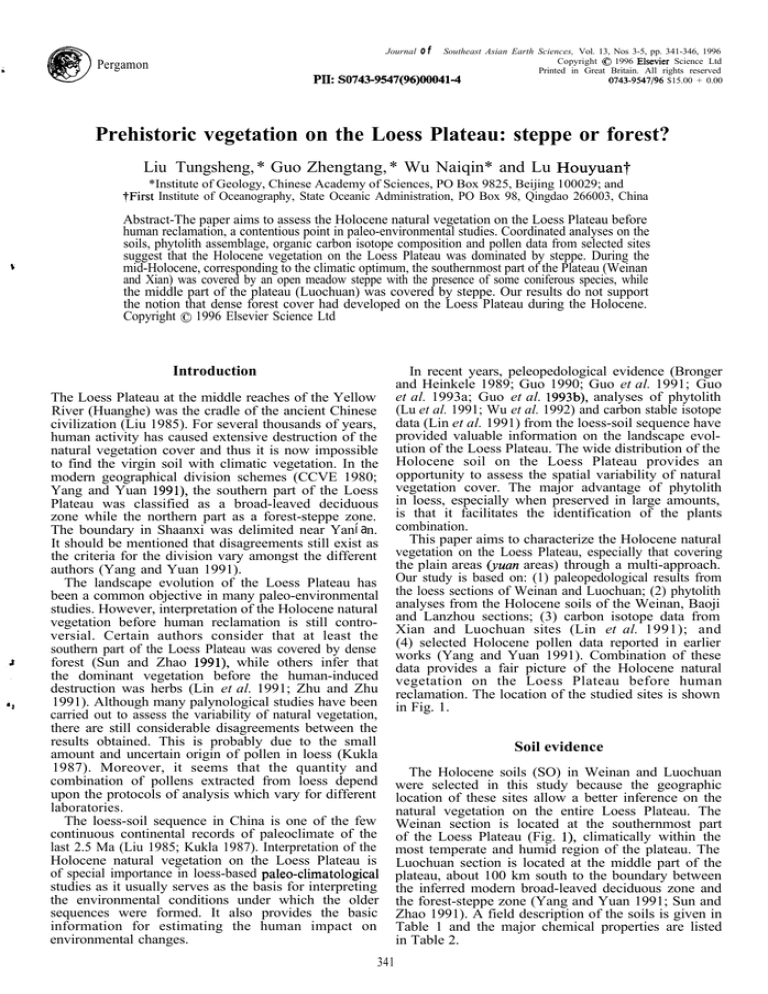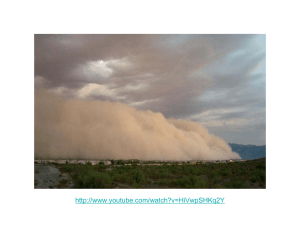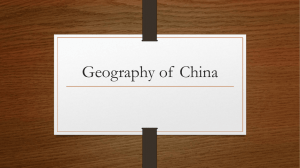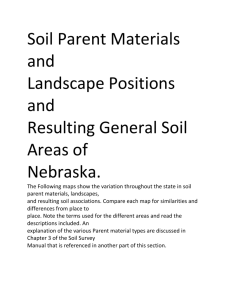
Journal
Pergamon
PII:
of
Southeast Asian Earth Sciences, Vol. 13, Nos 3-5, pp. 341-346, 1996
Copyright 0 1996 Elsevier Science Ltd
Printed in Great Britain. All rights reserved
SO743-9547(96)00041-4
0743-9547/96 $15.00 + 0.00
Prehistoric vegetation on the Loess Plateau: steppe or forest?
Liu Tungsheng, * Guo Zhengtang, * Wu Naiqin* and Lu Houyuant
*Institute of Geology, Chinese Academy of Sciences, PO Box 9825, Beijing 100029; and
TFirst Institute of Oceanography, State Oceanic Administration, PO Box 98, Qingdao 266003, China
Abstract-The paper aims to assess the Holocene natural vegetation on the Loess Plateau before
human reclamation, a contentious point in paleo-environmental studies. Coordinated analyses on the
soils, phytolith assemblage, organic carbon isotope composition and pollen data from selected sites
suggest that the Holocene vegetation on the Loess Plateau was dominated by steppe. During the
mid-Holocene, corresponding to the climatic optimum, the southernmost part of the Plateau (Weinan
and Xian) was covered by an open meadow steppe with the presence of some coniferous species, while
the middle part of the plateau (Luochuan) was covered by steppe. Our results do not support
the notion that dense forest cover had developed on the Loess Plateau during the Holocene.
Copyright 0 1996 Elsevier Science Ltd
Introduction
The Loess Plateau at the middle reaches of the Yellow
River (Huanghe) was the cradle of the ancient Chinese
civilization (Liu 1985). For several thousands of years,
human activity has caused extensive destruction of the
natural vegetation cover and thus it is now impossible
to find the virgin soil with climatic vegetation. In the
modern geographical division schemes (CCVE 1980;
Yang and Yuan 1991), the southern part of the Loess
Plateau was classified as a broad-leaved deciduous
zone while the northern part as a forest-steppe zone.
The boundary in Shaanxi was delimited near Yan’an.
It should be mentioned that disagreements still exist as
the criteria for the division vary amongst the different
authors (Yang and Yuan 1991).
The landscape evolution of the Loess Plateau has
been a common objective in many paleo-environmental
studies. However, interpretation of the Holocene natural
vegetation before human reclamation is still controversial. Certain authors consider that at least the
southern part of the Loess Plateau was covered by dense
forest (Sun and Zhao 1991), while others infer that
the dominant vegetation before the human-induced
destruction was herbs (Lin et al. 1991; Zhu and Zhu
1991). Although many palynological studies have been
carried out to assess the variability of natural vegetation,
there are still considerable disagreements between the
results obtained. This is probably due to the small
amount and uncertain origin of pollen in loess (Kukla
1987). Moreover, it seems that the quantity and
combination of pollens extracted from loess depend
upon the protocols of analysis which vary for different
laboratories.
The loess-soil sequence in China is one of the few
continuous continental records of paleoclimate of the
last 2.5 Ma (Liu 1985; Kukla 1987). Interpretation of the
Holocene natural vegetation on the Loess Plateau is
of special importance in loess-based paleo-climatological
studies as it usually serves as the basis for interpreting
the environmental conditions under which the older
sequences were formed. It also provides the basic
information for estimating the human impact on
environmental changes.
341
In recent years, peleopedological evidence (Bronger
and Heinkele 1989; Guo 1990; Guo et al. 1991; Guo
et al. 1993a; Guo et al. 1993b), analyses of phytolith
(Lu et al. 1991; Wu et al. 1992) and carbon stable isotope
data (Lin et al. 1991) from the loess-soil sequence have
provided valuable information on the landscape evolution of the Loess Plateau. The wide distribution of the
Holocene soil on the Loess Plateau provides an
opportunity to assess the spatial variability of natural
vegetation cover. The major advantage of phytolith
in loess, especially when preserved in large amounts,
is that it facilitates the identification of the plants
combination.
This paper aims to characterize the Holocene natural
vegetation on the Loess Plateau, especially that covering
the plain areas (j~uan areas) through a multi-approach.
Our study is based on: (1) paleopedological results from
the loess sections of Weinan and Luochuan; (2) phytolith
analyses from the Holocene soils of the Weinan, Baoji
and Lanzhou sections; (3) carbon isotope data from
Xian and Luochuan sites (Lin et al. 1991); and
(4) selected Holocene pollen data reported in earlier
works (Yang and Yuan 1991). Combination of these
data provides a fair picture of the Holocene natural
vegetation on the Loess Plateau before human
reclamation. The location of the studied sites is shown
in Fig. 1.
Soil evidence
The Holocene soils (SO) in Weinan and Luochuan
were selected in this study because the geographic
location of these sites allow a better inference on the
natural vegetation on the entire Loess Plateau. The
Weinan section is located at the southernmost part
of the Loess Plateau (Fig. l), climatically within the
most temperate and humid region of the plateau. The
Luochuan section is located at the middle part of the
plateau, about 100 km south to the boundary between
the inferred modern broad-leaved deciduous zone and
the forest-steppe zone (Yang and Yuan 1991; Sun and
Zhao 1991). A field description of the soils is given in
Table 1 and the major chemical properties are listed
in Table 2.
Liu Tungsheng et al.
342
Fig. 1. Location of the studied sites.
Holocene soil in Weinan
The upper part (Ap) of the soil was strongly reworked
by human activity as indicated by the abundant
charcoals and brick pieces. An argillic horizon (Bt) is
well preserved at the lower part, underlain by a Ck
horizon (Table 1).
The pH values vary between 7.4 and 8.3, suggesting
slightly alkaline environments. The exchangeable cations
are dominated by Ca*+ and Mg*+ and the adsorb
complex is saturated. The free iron content varies from
1.02 to 2%, indicating limited weathering degree. The
decrease of Si02/A1203 ratio and the increase of free iron
content in soils suggest weak pedological enrichment of
Fe-Al oxides and hydroxides. Earlier study (Guo et al.
1993b) on the Holocene soil in the nearby Xian loess
Site
Weinan
Luochuan
section (55 km west of Weinan) revealed that the clay
mineralogy is dominated by 2: 1 type. The soil contains
illites, kaolinite, chlorites, vermiculites, smectites and
interstratified minerals. The major difference from the
underlying loess layer is the slight increase in the content
of vermiculites and the decrease of chlorites, suggesting
that the weathering is in the stage of bisiallitisation
(Pedro 1979).
Micromorphologic investigations show that all the
soil horizons have dense incomplete excremental infilling
microstructure with abundant biopores (12-15%),
typical of steppe dominant soil with mollic epipedon
(Pawluk and Bal 1985). The dense excremental infillings
imply that the soil profile can be temporarily
water-saturated (Courty and Fedoroff 1985). This is
in agreement with the Fe-Mn hypocoatings (l-2%)
Table 1. Macromorphology of the Holocene soils at Weinan and Luochuan
Structure
Other characteristics
Depth (cm) Horizon Texture
Colour
some
brick pieces and
brown
moderate-large
granular
&20
clayish
silt
APL
charcoals, abrupt lower
(7.5YR4/4)
boundary
some brick pieces and
2&34
clayish silt
brown
moderate-large granular
Ap2
charcoals, abrupt lower
(7.5YR4/6)
boundary
34-70
Blt
brown
strong-large granular, fine- high humus content, 5%
silty clay
(7.5YR4/6)
loose granular substructure carbonate specks some clay
coating (5YR3/6), gradual
lower boundary
more humus, carbonate
dark brown strong-large granular
70-105
B2t
clayish
specks (57%) and clay
(7.5-5YR4/6)
coatings (5YR3/4), gradual
lower boundary
10% carbonate specks and
brown
moderate-large granular
105-143
B3
clayish silt
pseudomycelia
(7.5YR4/6)
143-153
brown
massive to weak granular 20% carbonate pseudomycelia
Ck
silty
and specks
(lOYR4/6)
massive structure at lower
brown
loose granular
O-40
silty
AP
part, some brick and ceramic
(lORY6/3)
pieces
some pseudomycelia at the
40-85
dark brown
AC
clayish silt
lower part
(1&7.5YR4/2)
abundant pseudomycelia
85-l 10
Ck
silty
brown
massive with biopores
(lOYR7/4)
Prehistoric vegetation on the Loess Plateau
Site
Weinan
Luochuan
1
t
Table 2. Chemical properties of the Holocene soils at Weinan and Luochuan
Exchangeable cations
CEC
(cmolc kg-’ earth)
Free iron %
(cmolc kg-’
PH
(CBD method)
earth)
Ca2+
Mg2+
Na+
KC
Horizon (water)
Blt
8.00
23.82
22.39
0.60
0.18
0.25
1.36
B2t
7.90
27.92
26.74
0.55
0.23
0.32
1.92
C
8.30
17.85
15.86
0.67
0.36
0.21
1.02
AC
8.75
18.50
15.30
2.20
0.23
0.27
Ck
8.65
13.40
8.40
4.45
0.20
0.35
C
8.50
8.25
5.15
2.35
0.45
0.35
around the biopores. The fine fraction (< 5 m) is dark
reddish-brown and humus-rich, containing some reddish-brown iron particles, indicating brunification and
weak rubification of the fine fraction. The clay coating
(- 5%) are dark brown (humus-rich), slightly dusty
and non-laminated with moderate birefringence.
According to Fedoroff and Goldberg (1982) this type of
humus-rich clay coating is usually associated with
vegetation containing some species providing fulvic acid
in relative abundance (e.g. coniferous trees). The above
features, combined with the chemical properties suggest
an ustic soil water regime and a mesic temperature
regime (Soil Survey Staff 1975). This soil can be classified
as Luvic phaeozem in the FAO classification system
(FAO-UNESCO 1974), Argiustoll in the U.S.A. system
(Soil Survey Staff 1975), Brunizem lessive in the French
ecological system (Duchaufour 1983) and a transition
type of Helu soil and Luvic thermo-black soil in the new
Chinese soil classification system (STCRG 1991). The
vegetation was dominated by dense steppe containing
probably some coniferous species.
Holocene soil in Luochuan
I
l
j
Similar to Weinan, the upper part (Ap) of the soil was
strongly disturbed by human activity. The lower part of
the profile consisting of an AC-Ck horizon sequence is
thought to be of virgin soil (Table 1).
Table 2 shows that the weathering environment was
slightly alkaline. The exchangeable cations are also
dominated by Ca*+ and Mg2+ and the adsorb complex
is saturated. Earlier clay mineralogical study (Liu 1985)
indicate that the soil and the underlying loess (Malan
loess) have a very similar clay mineralogical association.
They contain illites, kaolinites, chlorites and vermiculites. The difference between the soil and loess is
expressed by the decrease of the crystallinity of illites in
soil, suggesting that the clay minerals were mainly
inherited from aeolian dust.
Micromorphological study showed that decalcification had been achieved totally in the upper part of the
AC horizon, and partly in the lower part (2% primary
carbonates). The fine fraction is humus-rich, containing
a great amount of dark charcoal particles. The soil
has a typical spongy microstructure resulting from
strong biological activity, characteristic of steppe soils
with mollic epipedon (Pawluk and Bal 1985). The
well-preserved spongy microstructure, consistent with
the absence of Fe-Mn, indicates that the water regime
has been ustic and the profiles have rarely been
water-saturated (Courty and Fedoroff 1985). The lack of
rubification and the significant humus accumulation
343
Clay Si02/A1203
molecular ratio
3.94
3.68
4.23
suggest a mesic temperature regime of the soil (Soil
Survey Staff 1975).
The soil can be classified as haplic chernozem
according to the FAO system, vermustoll to the U.S.A.
system, steppe chernozem to the French system and
chernozem to the new Chinese system. This type of soil
is characteristic of dense steppe regions with semi-arid
and seasonally contrasted climate. The dry season is
usually too long for the development of forest cover
(STCRG 1991).
Phytolith assemblage
Phytolith is a biogenic hydrated silica (Si02.nHzO),
deposited in epidermal cells of plants. It is resistant
to weathering processes and is generally preserved in
large amounts in loess. Most of the phytolith can be
morphologically identified in line with plant classification (Lu et al. 1991). For example, dumbbell types of
the phytoliths are mostly derived from Panicoideas;
fan square and rectangular types can be produced by all
the subfamily of Gramineae, but the high content
of these types is statistically related to the warm and
relatively humid conditions; saddle phytoliths are
generally derived from Eragrostoideae; hat and tooth
types are only identified in Festucoideae; and granular,
irregular and rugose phytoliths were mainly found in
Chenopodiaceae and some other plants in desertic steppe
environments. The major phytolith types in loess in
line with plant classification were schematically reviewed
(Lu et al. 1991; Lu and Wang 1991).
The phytolith assemblages in the SO soils of Weinan
and Baoji are much similar. During the Holocene
climatic optimum, the association is dominated by
square and rectangle (30-40%), bar and point (25%),
and fan (15%) sharped phytoliths, combined with
dumbbell (3-5%), hat and teeth types (5-10%). The
irregular and granular types are in small amount.
Wooden phytoliths are scarcely observed. This
association suggests that the vegetation during the
Holocene climatic optimum in Weinan and Baoji was
dominated by Gramineae with an open meadow
landscape dominant. In Lanzhou, the phytolith assemblage of the mid-Holocene is dominated by granular and
irregular types (40-50%), characteristic of desertic
steppe landscape. Bar and point phytoliths represent
about 2&30%, combined with hat and tooth types
(lO-20%). Dumbbell, fan square and rectangular
phytoliths represent a total amount of about 10%. Those
from wooden plants were not observed. This association
indicates an arid steppe vegetation cover.
Liu Tungsheng et al.
344
Carbon stable isotope data
In the soil-loess sequence, the organic carbon stable
isotope composition is not only related to climate
conditions, but also to vegetation as the mechanisms of
photosynthetic pathway vary for different plants (Deines
1980; Luo 1985). C3 plants prefer relatively humid
environments and the slow rate of COz uptake results in
negative d13C values ranging from -22%0 to - 33%.
PDB (Deines 1980). C4 plants adapt generally to the
water-stressed environments with strong isolation and
high temperature. The d13C values of C4 plants vary
from - 10%0 to -22%0 (Deines 1980). CAM plants are
mainly found in arid environments and the d13C values
vary from - 9%0 to - 34%0 following the environmental
factors. The organic carbon isotope composition can,
therefore, be regarded as an indicator of paleovegetation. The organic carbon isotope composition in
the Xian (Duanjiapo, about 50 km southeast of Weinan)
and Luochuan loess sections was measured by Lin et al.
(1991). The d13C values in the Holocene soil vary from
approximately - 19%0 to - 23%0 in Xian, from - 19%0
to -22%0 in Luochuan. The results suggest that C4
plants were dominant during the Holocene at both the
two sites.
Among the -6000 species of C4 plants, about 5000
species are those in the family of Gramineae. Other than
these, about 1000 species of C4 plants were identified in
Aceanthaceae, Arizoaceae, Compositae, Chenopodiaceae
and Cyperacea, etc. (Wu et al. 1992). These results
suggest that the vegetation in Xian and Luochuan during
the Holocene was dominated by herbs.
Pollen records
Generally, pollen in loess is in small amounts and its
or.igin is thought to be uncertain as loess is a wind-blown
sediment (Kukla 1987). Moreover, the carbonate and
the microorganism in loess are unfavorable for the
preservation of pollen (Sun and Zhao 1991). The pollen
records in loess are, therefore, thought to be tentatively
significant, although better results from well-selected
sites can still be expected.
Loess in the southern part of the Loess Plateau usually
contains more pollens as the climate was favorable for
greater pollen production. Moreover, the wind strength
in the southern regions is weaker than in the northern
part and therefore the origin of pollen should be less
complicated. We quote here two published works (Yang
and Yuan 1991; Sun and Zhao 1991) from the southern
part of the Loess Plateau, one from Xian and another
from Fuping.
The Xian section is located at the archeological site
of Banpo. The Holocene pollen data are shown in
Fig. 2, which can be divided into three pollen zones.
The lowermost part of the profile (zone I) is dominated
by herbaceous pollens (99.5%), among these, Cruciferae
represents 50.6%, Leguminosae 10.2% and Caryophyllaceae 7.4%. The wooden pollens represent only
0.5%. This assemblage indicates a steppe vegetation,
corresponding to the Early Holocene. The middle
part of the profile (zone 111) is characterized by
an increase of coniferous pollens (7.3-31.9%). The
assemblage is, however, dominated by herbaceous
species (77.7-91.5%). The broad-leaved wooden pollens
N
I
(
Fig. 2. Pollen diagrams of the Holocene profile in the Xian
(Banpo) section (after Yang and Yuan 1991).
1 wooden pollens; 2 herbaceous and shrub pollens;
3 pteridophyte pollens; 4 cultivated horizon; 5 grey-brown
loess-like earth; 6 yellow-brown loess-like earth; 7 reddishbrown-grey loess-like earth; 8 brown-grey silty clay;
9 grey-yellow silty clay.
were found, but in small amounts (l-3%). This zone,
corresponding to the Holocene climatic optimum,
suggests a dense steppe dominant cover with some
coniferous trees. In the upper part of the profile (zone
112), the significant increase in Artemisia content and
the decrease in wooden pollen average content (4.9%)
provide evidence for a deterioration of climate during
the Late Holocene. The above results indicate that the
Holocene vegetation in Xian was dominated by steppe
cover. The climatic optimum was characterized by an
increase of coniferous species, which is in good
agreement with the pedological interpretation.
t
Prehistoric vegetation on the Loess Plateau
1
‘i
The Fuping section is located at the Yaochun village,
about 40 km northeast of Weinan city. The palynological analyses on the Holocene profile were reported by
Yang and Yuan (1991) and Sun and Zhao (1991).
During the Early Holocene, the pollen assemblage was
dominated by Artemisia and other herbaceous
species (92.3%), suggesting a steppe dominant vegetation cover. Wooden pollens dominated by Pinus
represent only 5.9% in average. The mid-Holocene was
still dominated by Artemisiu and other herbaceous
pollens (77.8~87.2%), combined with an increase
in coniferous species (8.4% on average) and Quercus
(5.3%). The assemblage of the Late Holocene is
characterized by an increase in herbaceous species
(83.4%) and a decrease in wooden pollens (9.4% on
average), suggesting the deterioration of climate during
the Late Holocene. These results allow us to conclude
that the vegetation in Fuping during the Holocene was
steppe-dominant. The Holocene climatic optimum was
expressed by an increase in wooden pollen content,
especially that of coniferous species, which is inconsistent with the interpretation of the Holocene soils.
Remarks and conclusion
I
‘8
The results from paleo-pedology, phytolith, organic
carbon stable isotope analyses and pollen records
suggest that the Holocene natural vegetation on the
Loess Plateau was dominated by various kinds of
steppes. During the mid-Holocene corresponding to the
climatic optimum, the southernmost part of the Plateau
(Weinan and Xian) was predominantly an open meadow
steppe with the presence of some coniferous species,
while the middle part of the plateau (Luochuan) was
covered by steppe. Our results do not support the notion
that dense forest cover was developed on the yuan areas
(the plains of loess) of the Loess Plateau, even during the
climatic optimum.
Our study does not exclude the possibility of the
presence of dense forests in hill or mountain areas as
well as in the valleys within the Loess Plateau, since the
local ecological conditions could be very different from
those of the yuan areas. It is commonly accepted that the
restrictive factor for the landscape of the Loess Plateau
is humidity rather than thermic conditions (An et al.
1993). According to our field observations, the presence
of forest in the hill and mountain areas may be explained
by the lower evapotranspiration at the shady sides
favorable to water conservation. The presence of some
wooden pollens (e.g. Quercus) in loess may be partly
attributed to the forests in these areas. This is also
consistent with the fact that the loess sections on the
fluvial terraces and those close to the mountain areas
usually contain more wooden pollens than those in the
yuan areas.
Acknowledgements-This work was supported by the National
Natural Science Foundation of China and the fund of the
director of the Institute of Geology, Chinese Academy of
Sciences.
REFERENCES
An Zhisheng, Porter, S., Wu Xihao, Kutzbach, J., Wang Sumin, Liu
Xiaodong, Li Xiaoqiang, Wang Jian, Zhou Weijian, Xiao Jiayi,
345
Liu Junfeng and Lu Jijun (1993) Holocene climatic optimum in
central-eastern China and eastern Asian monsoon. Chinese Sci.
Bull. 38, 1302-1305 (in Chinese).
Bronger A. and Heinkele T. H. (1989) Micromorphology and genesis
of paleosols in the Luochuan loess section, China: pedostratigraphic
and environmental implications. Geoderma 45, 123-143.
Chinese Commission for Vegetation Edition (CCVE) (1980) Vegetations in China. Science Press, Beijing (in Chinese).
Courty M. A. and Fedoroff N. (1985) Micromorphology of recent and
buried soils in a semi-arid region of Northwest India. Geoderma 35,
287-332.
Deines P. (1980) The isotopic composition of reduced organic
carbon. In Handbook of Environments. Al: Isotope Geochemistry,
The Terrestrial Environment (edited by Fritz P. and Fontes J. C.),
Vol. 1, pp. 329406. Elsevier, Amsterdam.
Duchaufour Ph. (1983) Pedologie, Tome I: Pedogenese et classification.
Masson, Paris, New York, Barcelone, Milan, Mexico, SLo Paulo.
FAO-UNESCO (1974) Soil Map of the Word. Vol. 1, Legend. Paris.
Fedoroff N. and Goldberg, P. (1982) Comparative micromorphology
of two late Pleistocene paleosols (in the Paris basin). Cufena 9,
227-251.
Guo Zhengtang (1990) Succession des paleosols et des loess du
centre-ouest de la Chine: approche micromorphologique. Ph.D.
Diss. University Pierre & Marie Currie, Paris, France.
Guo Zhengtang, Fedoroff N. and An Zhisheng (1991) Genetic types
of the Holocene soil and Pleistocene paleosols in the Xifeng loess
section in central China. In Loess, Environment and Global Change
(edited by Liu Tungsheng), pp. 93-l 11. Science Press, Beijing.
Guo Zhengtang, Liu Tungsheng, Fedoroff N. and An Zhisheng
(1993a) Shift of monsoon intensity on the Loess Plateau at ca.
0.85 Ma BP. Chinese Sci. Bull. 38, 586591.
Guo Zhengtang, Fedoroff, N. and Liu Tungsheng (1993b) Paleosols
as evidence of difference of climates between Holocene and the Last
Interglacial. Qunternary Sci. 1, 41-55 (in Chinese with English
abstract).
Kukla G. (1987) Loess stratigraphy in China. Quaternary Sci. Rev. 6,
191-219.
Lin Benhai, Liu Rongmo and An Zhisheng (1991) Preliminary
research on stable isotopic composition of Chinese loess. In Loess,
Environment and Global Change (edited by Liu Tungsheng),
pp. 124-131. Science Press, Beijing, China.
Liu Tungsheng (1985) Loess and the Environment. China Ocean Press,
Beijing.
Lu Houyuan and Wang Yongji (1991) A study on phytoliths in loess
profile and paleoenvironmental evolution at Heimugou in
Luochuan, Shaanxi Province since late Pleistocene. Quaternary Sci.
1, 72-84.
Lu Houyuan, Wu Naiqin, Nie Gaozhong and Wang Yongji (1991)
Phytolith in loess and its bearing on paleovegetation. In Loess,
Environment and Global Change (edited by Liu Tungsheng),
pp. 112-123. Science Press, Beijing, China.
Luo Yuehua (1985) Ecological significance of C3, C4 and CAM
pathways. Chinese J. Ecol. 5, 15-27 (in Chinese).
Pawluk S. and Bal S. (1985) Micromorphology of selected mollic
epipedons. In Soil Micromorphology and Soil Classification (edited
by Douglas L. A. and Thompson M. L.), pp. 63-84, SSSA Madison,
U.S.A.
Pedro G. (1979) Les conditions de formation des constituants
secondaires. In Pedologie 2: Constituants et Proprietes du Sol (edited
by Bonneau M. and Souchier B.), pp. 58-72. Masson, Paris.
Soil Survey Staff (1975) Soil taxonomy: a basic system of soil
classification for making and interpreting soil surveys. USDA-SCS
Agric. Handb. 436, U.S.A., Government Printing Office, Washington, D.C., pp. l-754.
Soil Taxonomic Classification Research Group (STCRG), Institute of
Soil Science, Academia Sinica and Cooperative Research Group on
Chinese Soil Taxonomic Classification 1991, Chinese Soil
Taxonomic Clusszjicution (1st proposal). Science Press, Beijing.
Sun Jianzhong and Zhao Jingbo (1991) Quaternary Geology of the
Loess Plateau. Science Press, Beijing (in Chinese).
Wu Naiqin, Lu Houyuan, Nie Gaozhong, Wang Yongji, Men Yi and
Gu Guoan (1992) The study of phytoliths in C3 and C4 grasses
346
Liu Tungsheng et al.
and its paleoecological significance. Quaternary Sci. 3, 241-251
(in Chinese with English abstract).
Yang Qinye and Yuan Baoyin (1991) Environment on the Loess
Plateau Regions and Its Evolution. Science Press, Beijing (in
Chinese).
Zhu Xianmo and Zhu Yizhi (1991) A preliminary study on the soil on
the Loess Plateau and its environment-a comparison between
earth and soil on the Loess Plateau. In Quaternary Geology and
Environment in China (edited by Liu Tungsheng), pp. 213-279.
Science Press, Beijing, China.








